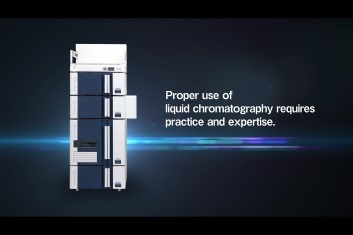Chromatography Data Station ChromAssist Data Station
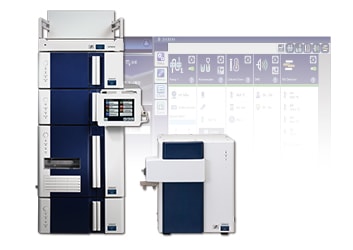
Highly rated, highly reliable Hitachi HPLC Chromaster series. The ChromAssist Data Station is a “Chromatography Data System (CDS)” for centrally managing Chromaster series modules, and streamlining the entire process from measurement and analysis to reporting. ChromAssist supports high-performance liquid chromatography (HPLC) analysis with a variety of features based on user preferences, and analysis guidance features that incorporate Hitachi’ s many years of knowledge.
* "ChromAssist "is a registered trademark of Hitachi High-Tech Science in the EU.
Features
-
Intense pursuit of user-friendliness
Highly-versatile HPLC can be used in a wide range of ¬fields including pharmaceuticals and food products, as well as the environmental and chemical industries. However, one of the challenges in analytical work is that specialized knowledge and experience are required.
With ChromAssist, we have enhanced the guidance features for analytical operations with a user orientation in pursuit of user-friendliness (even for ¬first-time users) to enable simple execution of each analytical task. -
Reduces the complexity of analytical work
We have focused on making it easier for users to fully master the proper implementation of HPLC. To this end, we have enhanced the assistance features to reduce the time spent for routine performance con¬firmation as well as complex maintenance and troubleshooting regarding analytical work.
Friendly graphical user interface (GUI)
Operations can be performed using an intuitive screen with each parameter represented by an image.
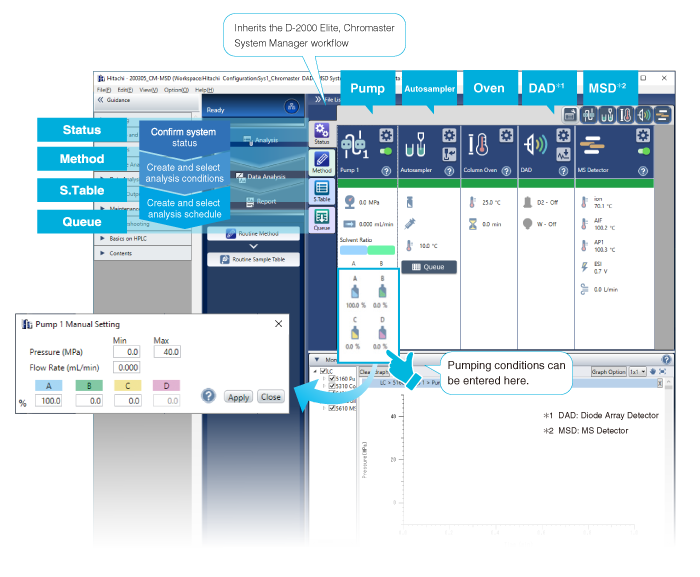
Enhanced navigation and guidance features
Loaded with guidance features and enhanced help features to support the overall analytical workflow, from starting up the device through testing, analysis, maintenance, and troubleshooting. There is no longer a need to refer to a manual. Intuitive tutorials have been prepared for fi¬rst time users.
Recording analytical procedures as routine analyses, making repeated measurements easier. Furthermore, the guidance features include content for different purposes, such as LC and MS basic lectures, maintenance videos, and troubleshooting.
These can be conveniently viewed during the measurement.
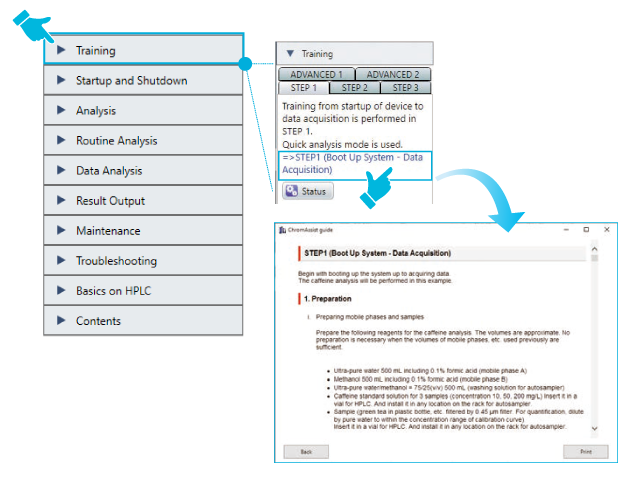
Display of the analysis log can be used to assess system stability
To obtain accurate analytical results, it is important to fully ensure device and system performance, including the column. Degradation of the column and variations in detection sensitivity can be easily determined by recording a summary of the theoretical number of plates, the resolution, and the reproducibility (SD, RSD). In addition, by setting RT window for results, assessment comments (Pass/Fail) can be noted, and the stability of the system can be assessed on a daily basis.
System performance check
Data acquired for each analysis can be checked for quality. System Suitability Test (SST) reports conforming to the Japanese, US, and European Pharmacopeias (JP, USP, and EP) and operation check results that classify the operating conditions for each HPLC module can be summarized in a report.
System suitability test report
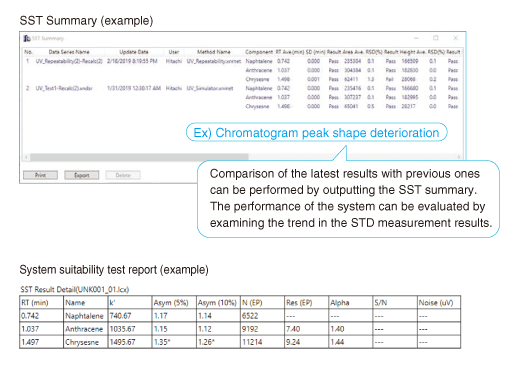
This is useful for evaluating the overall analysis system. In addition, degradation of the column and other components can be evaluated by checking the theoretical number of plates each day.
Daily maintenance support
To ensure that each HPLC module is in good condition, it is important to monitor and manage consumable parts. Part replacement dates, usage history (liquid feed amount, number of uses, cumulative time, etc.), and guidelines for recommended replacement can be recorded and checked to monitor the condition of consumables. This information can be output as a report or stored in a log. In addition, when it is time to replace a consumable, the Assist feature provides visual support through maintenance videos.
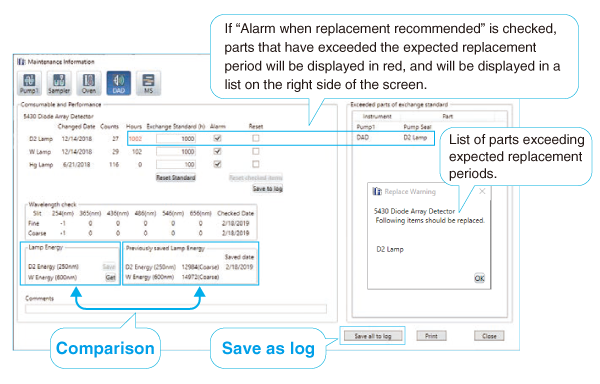
Troubleshooting support
We have published a collection of specific troubleshooting examples in a guide and we provide support to resolve problems such as abnormal analytical results. These examples reflect the experiences of both Hitachi and Hitachi users collected over many years.
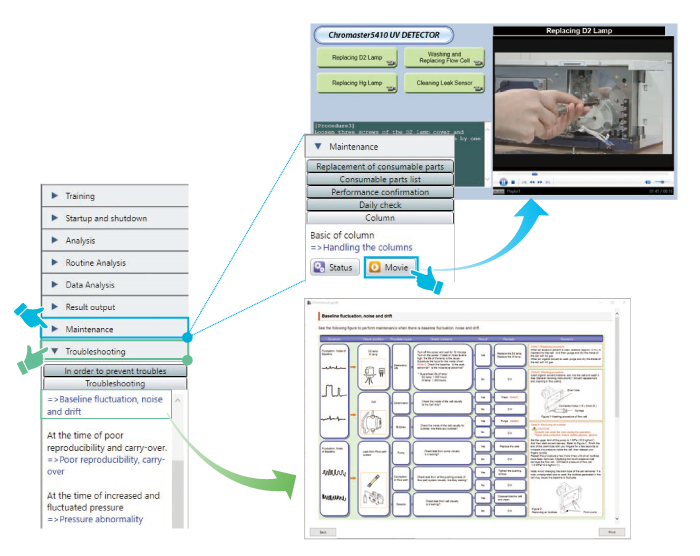
Supporting modules
ChromAssist supports Chromaster, ChomasterUltra Rs, LaChrom Elite and LaChrom Ultra series modules which are described below.
Chromaster modules
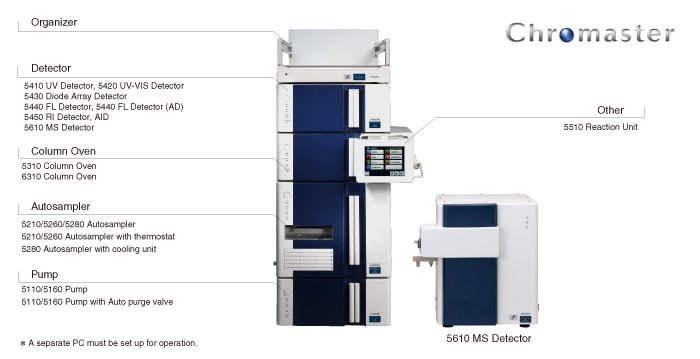
ChomasterUltra Rs modules
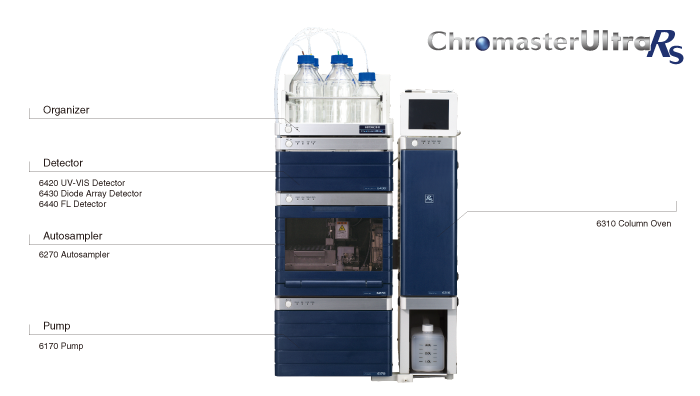
LaChrom Elite modules:
L-2100 Pump, L-2130 Pump, L-2200 Autosampler, L-2300 Column Oven, L-2350 Column Oven, L-2400 UV Detector, L-2420 UV-VIS Detector, L-2455 Diode Array Detector, L-2480 FL Detector, L-2485 FL Detector, L-2490 RI Detector, AID and Organizer.
LaChrom Ultra modules:
L-2160U Pump, L-2200U Autosampler, L-2300 Column Oven, L-2350 Column Oven, L-2420 UV-VIS Detector, L-2455U Diode Array Detector and L-2485U FL Detector.
*
Note:
ChromAssist can control a maximum of up to 2 systems in the same (or different) series at the same time.
However, please avoid using combining modules of each series in one system.
Specifications
Please refer to the following specification.
| ChromAssist Data Station | ||
|---|---|---|
| Module control | System series name | Chromaster, ChromasterUltra Rs, LaChrom Elite, LaChrom Ultra *1 |
| Number of systems | Maximum of 2 systems (however, up to 1 MS Detector) | |
| Number of data acquisition channels | 10 – 3,200 ms (L-2400/2420/2455/2480/2485, 5450, AID: 50 – 3200 ms L-2490: 100 – 3200 ms) |
|
| Analog input | AID (1 ch/board, 2 boards/system, maximum of 2 ch) (however, data collection cycle 50 ms minimum) | |
| Supported PC | OS | Windows computer *2 |
| Software | DAD control / analysis (standard specification) | |
| System suitability test (standard specification) | ||
| Data analysis features | Integration processing | Peak determination depending on noise and peak sensitivity |
| Configurable integration method such as vertical partitioning, tailing, and integration inhibit | ||
| Quantitative calculations | Calculation methods: No Calibration(percentage method), Normalized Percent, External Standard, | |
| Internal Standard,Standard Addition, Manual | ||
| Calibration curve order: linear R, linear C, Quadratic and Cubic, | ||
| Calibration curve weight; 1.0, Conc, 1/Conc, 1/Conc*Conc. Force zero. | ||
| Multiple point calibration curve: maximum 20 points | ||
| Data diagnosis | Diagnostic peak area/height, expected concentration peaks | |
| System suitability test | Theoretical number of plates, Resolution, Asymmetry(5%), Asymmetry(10%), Signal to Noise, Retention time(Standard deviation), Area(Relative standard deviation), Height(Relative standard deviation) | |
| Calculation methods | USP、EP、JP | |
| Statistical calculation features | Calculation items | Retention time, Area/Height |
| Results | Average, SD, RSD | |
| DAD acquisition / analysis features | Extraction chromatography | 4 wavelengths fixed chromatogram, Best wavelength chromatogram |
| Peak purity check | Enable (Peak height percentage for side spectra (upslope point and downslope point) ) | |
| Library search | Enable (Spectral library search, Reverse library search) | |
| Mass acquisition / analysis features | Mass chromatogram extraction | Possible (Extract designation m/z from scan data, Extract from TIC and scan data acquisition) |
| Report | Layout | Can be created with Report Layout Editor |
| Other | Output as Microsoft Excel file *3 | |
| Export | Data conversion | CSV files |
| Graphical image export file formats (PNG, BMP, TIFF, Enhanced Meta File) | ||
| AIA(Net CDF)files | ||
| Other | Part 11 support function | FDA 21 CFR Part 11 support function installed |
*1 The supporting modules of ChromAssist are described in “Supporting modules” in detail.
*2
Microsoft® Windows® 10 Pro, Version 1809/1909, 64 bit, English Version
1920 × 1080 (Full HD) or more as of April 2020.
*3 Microsoft® Office Excel® 2016 or 2019 (English Version) is required.

